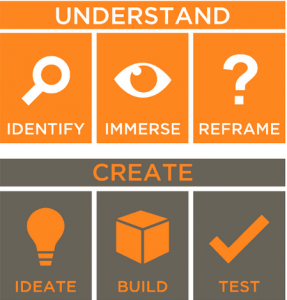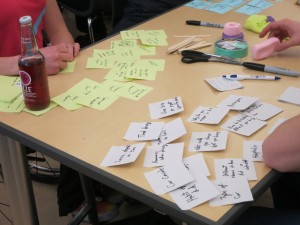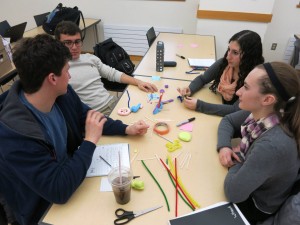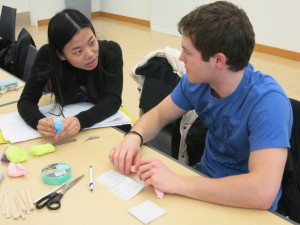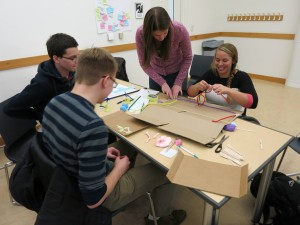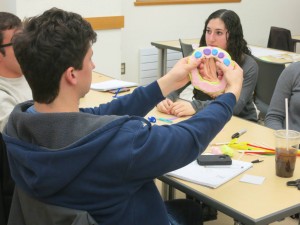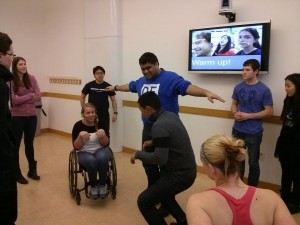The third industrial revolution is upon us, and we have the ability to create functional products on our desktop by using some inexpensive and accessible tools. This course was designed to help get students trained on many of these tools and technologies and make things. Students will explore 3D scanning, modeling and printing to rapidly prototype products. They will experiment with open hardware /micro-controllers such as arduinos and smaller form factors for e-textiles, to explore the concept of the internet of things. They will also have guest lectures in entrepreneurship, design thinking, digital making and some stories from passionate makers from the community and beyond.This new seminar course is being offered by Dr. Vishal Sachdev.
The course kicked off with a discussion on the possibilities of digital manufacturing and we were fortunate to have a great presentation on the disruptions on supply chains from guest speakers. Students are responsible for documenting their own learning in the class blog at http://publish.illinois.edu/digitalmaking, in an effort to take the learning out of the classroom and share with the world. The students will also learn from maker communities on the web, besides learning from experts who can come and conduct workshops locally. The post below is the first such post by Kavin Chinnaswamy, a senior in Supply Chain and IS/IT with a passion in evaluating the impact of additive manufacturing on supply chains.
Having taken up Supply Chain Management and Information Technology as my courses of study, I never expected to want to learn about 3D printing – I had only come to learn that objects could be ‘printed’ about a year ago, when I had walked in to the MakerLab at the Business Instructional Facility at the University of Illinois. Imagine my delight when I came to learn of a course that facilitated education about 3D printing through making, learning and sharing – the . Now make note that I used the word ‘facilitated’, because the DMS experience isn’t your regular Illinois classroom experience, where you wake up at 7am and grudgingly head to the Foellinger Auditorium, learn through the professor’s instruction, textbook readings, homework and exams (ugh!). The DMS is an unstructured course with students from all over campus, ranging from Finance and Accountancy majors to Aeronautical engineers and Lawyers! No exams, fun homework assignments, and an instructor who learns with you. What’s more, there’s barely any theory, you learn through what you ‘make’ and through what the others around you make and learn. Grading itself is based on the three philosophies of the class – making, learning and sharing, each worth a third of your grade. Each session usually includes a guest speaker who is an expert in Additive Manufacturing (the correct term for 3D Printing, something you’ll learn if you take the course.
With my major, I was naturally interested in how additive manufacturing would impact Supply Chains. I was sure that they would indeed have a big impact, but wasn’t sure how. Enter our guest speakers for the first session of the DMS – the founders of Senvol. Senvol is an additive manufacturing solutions provider to many Fortune 500 companies. It was founded by Zach Simkin and Annie Wang, both of whom are Wharton MBA graduates. Their first teaching – just because additive manufacturing can be used in a product’s supply chain does not mean it has to be used. Through Skype, they explained the seven scenarios that they had come up with to identify areas of a supply chain where there is potential for cost and time savings through the use of additive manufacturing. The scenarios are explained to firms as follows:
- Expensive to Manufacture: Do you have parts that are high cost because they have complex geometries, high fixed costs (e.g. tooling), or are produced in low volumes? AM may be more cost-efficient.
- Long Lead-Times: Does it take too long to obtain certain parts? Are your downtime costs extremely high? Through additive manufacturing, you can often get parts more quickly.
- High Inventory Costs: Do you overstock or understock? Do you struggle with long-tail or obsolete parts? AM can allow for on-demand production, thus reducing the need for inventory.
- Sole-Sourced from Suppliers: Are any of your critical parts sole-sourced? This poses a supply chain risk. By qualifying a part for AM, you will no longer be completely reliant on your current supplier.
- Remote Locations: Do you operate in remote locations where it is difficult, time consuming, or expensive to ship parts to? AM may allow you to manufacture certain parts on-site.
- High Import / Export Costs: Do you pay substantial import/export costs on parts simply because of the location of your business unit and/or your supplier? On-site production through AM can eliminate these costs.
- Improved Functionality: AM can enable a part to be redesigned such that its performance is improved beyond what was previously possible, resulting in increased profit margin or market share.
Mr. Simkin and Ms. Wang also described their newly created AM database which has information regarding the current range of materials that are capable of being used in AM and the machines that are capable of using them
Mr. Simkin also briefly stated that additive manufacturing could be used as a means of reactive capacity. Reactive capacity is a firm’s production capacity after the initial sellout of products produced through their speculative capacity. Speculative capacity is often dictated by demand forecasts, which are not the most accurate means of creating orders that completely satisfy the firm’s demand for the current period. This can be better explained through an example. Let us assume that BRZ is a company that manufactures New England Patriots and Seattle Seahawks licensed football helmets through their plant in China. Given the Patriots’ emphatic Super Bowl win, Patriot’s helmets are highly likely to get sold out, BRZ could miss out on huge sales for no fault of their own, and blaming Pete Carroll isn’t going to help them. But additive manufacturing can. Manufacturing another batch of helmets through China could take over a month, by which time the demand for Patriots’ helmets will have almost completely died down. AM, on the other hand, will help have those helmets shelf-ready in a week or even earlier, depending on the resources available to BRZ. The helmets may be more expensive to manufacture through AM, which could cause decreased profit margins, but hey, some profits are better than no profits at all, and then there’s the fact that BRZ will not upset the retailers that order from them, as no sales means that retailers are not able to capitalize on that trophy-winning interception by Malcolm Butler.
To sum it all up, additive manufacturing may not have a dramatic impact on supply chains in the near future due to it’s current limitations, but the future looks promising. With more and more materials coming under the AM banner, expect to see big changes in the supply chain’s of all physical products.
Stay up to date with the reflections from students on our class blog at http://publish.illinois.edu/digitalmaking/ or follow our hasgtag #DigitalMaking on twitter.
